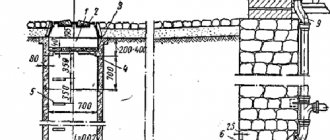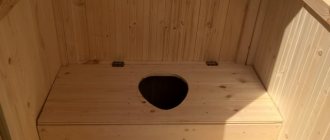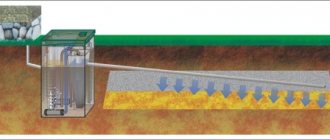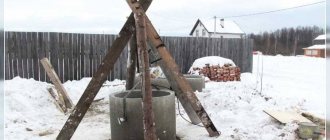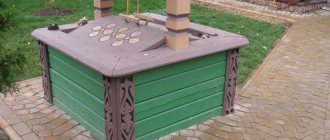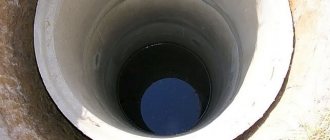The issue of water supply will probably always be relevant, especially in rural areas. And often the problem of water supply is solved by erecting a well that performs a direct function (in other words, providing the area with water), but at the same time it must be reliable and durable. To prevent it from freezing in winter, it should be properly insulated even before the onset of cold weather. There are many different insulating materials suitable for this purpose. You just need to know how to properly insulate a well for the winter.
- 1 In what cases is insulation required?
- 2 Method one. Cover insulation
- 3 Method two. We thermally insulate the upper ring of the structure 3.1 We use polystyrene foam for the “under the fur coat” ring
- 3.2 We use polyurethane foam for the ring “under a fur coat”
- 4.1 Video – House installation
- 7.1 Video - Insulating a well
Insulation of a country well from concrete rings
Insulating the topmost ring of a well is actually not that difficult. The technique of this procedure is quite clear and primitive. To explain briefly and concisely, the top concrete ring needs to be covered with the familiar polystyrene foam.
Let us consider in detail the progress of the work to be performed
- The wall ring needs to be dug out twenty centimeters - to the depth of ground freezing. In total you will have to go deeper by about 1.2 meters. Since this is not very comfortable to do, you will have to dig a fairly large pit. If you count the rings from above, then it is enough to get by with a depth of 20 cm below the junction of the first two rings.
- We take layers of foamed polymer and cut it into strips 20 cm wide. High-density material is more suitable, and the best option would be to purchase extruded or ordinary foam.
- We clean the wall rings from dust and dirt, moisten them with water, and glue the parts of the prepared foam polymer with special glue.
- When the surface of the ring is fully covered, the gaps between the individual strips of foamed polymer are filled with foam for installation. Its remains are cut off after complete drying, the soil around the well is added, and the well itself is put in order.
So that the foam for installation work does not fade in the sun and the foamed polymer does not deteriorate, the structure is reinforced with a mesh and then covered with a layer of plaster. This option is very effective, but it doesn’t really help in all cases: the cold can penetrate through the top.
Thanks to this, it will be better, without delay, to move on to the next insulation method with your own hands.
Making a warm shutter
What is a warm shutter?
It must be stated that this is a specialized cork with small holes made in it. One of them serves for ventilation and prevents water spoilage. The second is for the intake hose. This option will be optimal for a summer cottage, which is supplied with well water using a pump.
How to make such a shutter lid?
- It is necessary to make two similar rings from moisture-resistant plywood, corresponding in size to the inner diameter of the concrete ring of the well.
- One of the rings is covered with 5-centimeter polystyrene foam. All remnants are carefully cut off: the foam circle should exactly repeat the shape of the plywood one.
- The second plywood circle is glued on top of the foamed polymer.
- Final stage. We drill two 6-centimeter holes (for ventilation and for the hose), make a handle to which we attach a thick rope or chain, so that in the spring you can easily remove this plug.
There is nothing difficult in all these events, but there is also no special beauty here.
It should be noted that the considered methods of thermal insulation with polystyrene foam are suitable only if the water supply is carried out using a pump.
If water is taken from the well with a bucket and a collar, then it is unlikely that the stopper will help. In this case, there is another, third method of insulating a well with your own hands.
Insulation of water wells
This is an excellent option for every occasion. There is an optimal way to thermally insulate a well, which solves several problems at the same time: the appearance of the site outside the city will not be affected at all, and the insulation will be done really well. This primitive and good method is the construction of a special closed well house.
Closed well house
This design solves the following problems:
- Prevents water from clogging with leaves and other small debris. A thoughtful and airtight house with a tight lid will not allow anything unnecessary to get into the source.
- The well will not freeze in winter. In the only case such a house will not save you from freezing if the water level in the well is higher than the ground freezing level. If this is the case, then it will be necessary to implement additional insulation of the upper wall ring with polystyrene foam.
If insulating a well yourself seems too difficult to you, you can make the task easier for yourself. At a minimum, you won't have to do most of the work yourself. Foam half-rings, a warm seal and good sealed houses themselves can be purchased at hardware stores.
All you need to do is install such products, and this, of course, is several times easier. Well, factory-made products, in most cases, will look much more beautiful than homemade ones. This is especially true for a well house. Still, only homemade interior items will give the site an original and distinctive look.
How to insulate a well for the winter with your own hands at the installation stage
When constructing various types of wells, their protection against freezing should be considered at the installation stage, using various methods. The easiest way to protect sources from the cold is with plastic casing columns and black HDPE pipelines, which, unlike metal ones, have much lower thermal conductivity, have high technical characteristics and are widely used in everyday life.
By using modern technology to submerge a submersible pump using a downhole adapter placed on the side wall of the casing below the depth that causes freezing, protecting the entire plumbing system is greatly simplified.
If a surface pump is used in a caisson well, it is best to insulate it from the outside with rigid materials (foam plastic, Penoplex) - this method saves more heat than internal insulation. If necessary, you can use joint insulation outside and inside the well; in the latter case, the use of soft self-adhesive Penofol is allowed.
When a caisson made of concrete rings or strong sheet steel is installed, it can be sprinkled with expanded clay for additional insulation, and the channels with water supply can be laid on top with rigid sheets of any kind, thereby creating an insulating air cushion or covered with the same expanded clay.
A well-known method of combating freezing is the effect of using water in motion, in which its crystal lattice does not have time to line up - thanks to this, you can use a small stream of water flowing from the tap to combat the threat of freezing.
It should be noted that the method known from the Internet for combating pipe freezing by increasing pressure is ineffective - to reduce the crystallization temperature by 1 degree, you will have to pump 130 atmospheres into the main line, which is unrealistic for a household water supply.
Rice. 8 Design of a plastic caisson installed on wells
Options and methods for insulating various wells
As noted above, the main problems arise when insulating wells located in caisson wells - they must contain external pipelines and equipment, and often there is a surface pumping station.
If you use a submersible pump connected through a well adapter located underground at the freezing depth level, for additional protection you can simply seal the wellhead with any type of thermal insulator.
If the adapter is structurally close to the surface, using a small piece of heating electric cable, lowered into the tee pipe to connect it, is the simplest and most effective option. In this case, the water will be heated in the pressure pipe and enter the water main at a high temperature.
One of the options for domestic wells is homemade Abyssinian species for shallow water layers. Their distinctive feature is their shallow depth of up to 30 m and the diameter of the casing string no more than 2 inches, which is replaced by a section of HDPE pipe. For water intake, surface electric pumps are used, installed in a warm room, the water supply usually runs along the surface, the dynamic level of the water surface does not fall below 9 m. To heat them, it is optimal to use a heating electric cable passed inside a shell-insulated water intake hose - conventional insulation on the surface alone is ineffective and in any case, an additional heat source will be required.
Rice. 9 Here's how to insulate a well for the winter with your own hands: you can install an insulated box on the surface of a well or well
Article on the topic:
Everything for thermal insulation of pipes - materials, application, installation technology . If you are reading about how to insulate a well for the winter with your own hands, then it will probably be useful to read a separate article about all types of thermal insulation materials used indoors or outdoors.
Installation of insulation
The best option for installing insulation are rigid shells of various sizes made from PS foam, extruded polystyrene foam and PPU polyurethane foam. They can be made to order, the products consist of segments in different quantities, and during installation they are inserted into each other to avoid cold bridges.
Shells are used to insulate water supply pipe systems, well rings used to construct caisson chambers, and all types of ready-made round caissons made of metal and plastic. The segments are installed on the pipes with a shift; they are fixed using adhesive tape, ties or glue.
The advantage of shells is the ability to disassemble them without damaging the surface and reuse them. The service life of foam insulation is from 30 to 50 years; all types are resistant to direct solar radiation, resistant to rodents, biological and chemical effects of most aggressive substances, and have low hygroscopicity and water absorption.
Rice. 10 Insulation of a caisson for a well - examples
Insulation of a well with a caisson
Caissons are made from a fairly large number of building materials, the main ones being brick, pouring concrete formwork, well rings, finished factory products made of plastic and sheet steel 3 - 6 mm thick. Sometimes when installing them, rarer building structures are used in the form of square or rectangular concrete wells, various types of slabs, foam concrete blocks, slag concrete, and large-section polymer pipes.
The main shapes are rectangular (square) and round; it is more practical to make external insulation not only from the point of view of efficiency, but to save space inside the chamber - in this case, less material will be required for its manufacture, and additional thermal insulation can always be made inside if necessary.
When insulating, it is important to provide ventilation and seal the entrance hatch; for this, lightweight plastic covers are usually used, and the upper part of the well is finished with one of the thermal insulating materials listed above.
It should be noted that the caisson is mainly used for installing surface equipment in the form of pumping stations; for submersible pumps, it is correct and much cheaper to use a downhole adapter installed on the wall of the upper part of the well (casing pipe, for strength it must be made of metal).
Rice. 11 How to insulate a well for the winter with your own hands without a caisson
Insulation of a well without a caisson
Quite rarely, situations arise when the casing pipe is at the same level with the ground or slightly higher without a caisson and downhole adapter, and surface or submersible electric pumps are used for water intake. In this case, the water pipe goes to the house in which the pumping equipment is located, along the ground, and the easiest way is not to insulate it, but to lower an electric heating cable into the pressure pipeline and increase the temperature of the water at the entrance to the water main. Since moving liquid practically does not freeze, a cable with a power of 10 watts per linear meter is quite enough to protect against the cold.
It is known that in deep artesian springs, with high pressure from layers of earth on the water basin, water often rises a considerable distance upward, and additional insulation of the casing pipe, which is often made of metal, may be necessary.
In what cases is insulation required?
If the well was built according to ancient traditions (read: made of wood), then, of course, it does not need any thermal insulation. There are exceptions - for example, a well cover needs insulation. In this case, it is necessary to make an additional cover from wood and fix it inside the structure itself. This cover will protect the country well from:
- snowfall;
- temperature changes;
- ingress of dry leaves and other debris.
Note that almost all modern wells are constructed using reinforced concrete rings. Such wells have numerous advantages, including:
- strength;
- reliability;
- durability;
- ease of installation and further maintenance.
Despite this, they have one significant drawback: they need to be insulated for the winter.
On a note! If the water in the structure is located below the soil freezing level, then the structure itself will not freeze. But if it’s higher, then installation of insulating material is required!
There are three thermal insulation technologies:
- insulation of the structure cover;
- thermal insulation of the upper ring;
- construction of a decorative house.
Let's take a closer look at each of the possible methods.
Method two. We thermally insulate the upper ring of the structure
Every specialist will tell you that in order to prevent freezing of a well, you need to reduce the thermal conductivity of its upper ring. This method of thermal insulation is performed in two ways:
- by means of polystyrene foam;
- using polyurethane foam.
Let's look at the first method first.
We use polystyrene foam for the ring “under a fur coat”
Here you should prepare the following consumables for work:
- polyurethane foam;
- paint;
- plaster;
- insulating blocks made of polystyrene foam, which are connected using a tongue-and-groove system.
On a note! According to this technology, the first ring on top will be completely insulated, while the second only partially. Now to work!
Step one. Work should begin with preparatory activities. Dig a pit 20 centimeters wide and approximately 0.5 meters deep around the ring. Then thoroughly clean the surfaces from dirt and install the first “fur coat” ball. At this time, make sure that the density of all connections is maximum! Blow out the joints with foam to seal them. Having finished with the first level, proceed to assembling the second and gluing it to the ring. Blow out the gaps that have formed between the layers with foam.
Step two. Next, begin plastering the surface of the rings. This will protect the foam from the negative effects of the sun's rays, which, as we know, worsen the thermal insulation properties of this material. After the plaster has completely dried, apply paint to it - this will prevent the finish from getting wet.
Step three. All that remains is to fill the pit and thoroughly compact the earth.
Penoplex, we insulate the foundation reliably and correctly
We recommend that you read our article on insulating the foundation yourself. You can find out more here
We use polyurethane foam for the ring “under a fur coat”
If you chose polyurethane foam as insulation, then follow these steps. First, dig a similar pit (as in the previous method of insulating a well for the winter), and then build a wooden frame around the first ring. But this is in general terms; let’s analyze the procedure in more detail. Prepare the following materials for work:
- paint;
- dowels;
- polyurethane foam sprayer;
- collapsible metal formwork;
- plaster;
- a piece of plastic film;
- wooden bars.
Step one. Traditionally, start by digging a pit, but narrower (maximum 10 centimeters). After this, install bars around the first ring in increments of approximately 40 centimeters. Cover the edges of the trench with formwork made of thin sheet steel, which will exactly follow all the contours. Cover the formwork with the prepared film. For what? This is explained by the fact that the adhesion of foam plastic is very significant, and therefore dismantling the formwork is impossible.
Step two. Having finished building the formwork, you will notice that a void has formed between it and the ring - this is what needs to be filled with insulation. Upon completion of pouring, the polyurethane foam will increase in volume, and the trench will therefore be filled as densely as possible.
After this, you need to wait until the material is completely dry. As soon as this happens, dismantle the formwork. Plaster the finished surface and apply a layer of paint to it. Fill the void left after formwork with earth and compact it thoroughly.
On a note! It is also advisable to cover the well with a lid, which was described in one of the previous paragraphs of the article.
How to work with polyurethane foam
To insulate the walls of the upper ring with polyurethane foam, you will need the following materials:
- oil paint;
- polyethylene film;
- metal elements for formwork;
- dowels;
- plaster;
- wooden beams.
A trench for insulation with polyurethane foam needs to be 10 cm wide. It is lined along the edge with a special formwork, the elements of which are made of thin steel sheets. It is laid exactly along the contour of the trench. So that the formwork can be removed later, a plastic film must be stretched over its surface.
Around the upper well ring, bars are placed every 40-45 cm . When everything is prepared, polyurethane foam should be poured into the free space inside the trench. This is done with a special sprayer. Polyurethane foam gradually increases in volume. Therefore, you need to handle it carefully to prevent overspending.
After the polyurethane foam has dried, you need to carefully remove the sheet formwork; the surface is plastered. Then 1 coat of paint is applied. You need to pour soil into the cavity that will remain after removing the formwork and compact it thoroughly. An insulating cover is also necessary in this case. It can be done using the technology described above.
Construction of a decorative house
The advantages of the house are that it not only insulates the well, but also protects the source from dirt and decorates the area as an element of landscape design. Types of well houses:
- roof mounted on shaft rings;
- a log house similar to a gazebo;
- large 2-pitch roof covering concrete rings;
- with canopy;
- with a winch.
Materials for its construction:
- Brick, building blocks or concrete. With their help, the structure can be given any shape. It is durable and inexpensive, but requires cladding.
- Metal. This option is chosen by lovers of high-tech style. The metal frame is sheathed with sheet iron.
- Natural stone. It is easier to lay flagstone, because... it's flatter. The house from it looks natural.
- Tree. Due to its high performance and aesthetic appearance, it is most often chosen.
Walls that are too thick will make the structure bulky, and thin, lightweight structures will not withstand wind and other loads.
The house should not stand on the ground, but on a concrete platform. Therefore, work begins with it, taking into account the following:
- the platform must be reinforced;
- concrete layer - at least 15 cm;
- it is necessary to make a slope for water drainage;
- if a project with a canopy and a winch is selected, racks for them are installed before the site is poured.
The stages of building a house depend on the materials chosen, but installation always begins with the construction of the frame. Afterwards, the space between the walls of the house and the well is insulated, for example, with expanded clay. The structure is decorated with carvings, painting parts in different colors, artificially aging wooden surfaces, and installing figures made of wood or plaster.
Preventing the well from freezing
To prevent the well structure from freezing with the onset of winter, thermal insulation should be taken care of during its construction. If the suburban area will be visited occasionally (for example, only on weekends), then, in principle, there is no need to insulate the well. In such cases, it is only necessary to clean it and treat it with some kind of disinfectant (such as chloramine) before leaving.
After this, pump out the water completely and close the structure with a lid. Lay a polyethylene film over the lid and cover it all with leaves. Now you can go to the city with a clear conscience, because with the onset of warmth, the well will again provide clean water.
But if the well is used regularly, then the measures should be more serious. For example, pipes to the house must be located below the soil freezing line, the structure itself must be protected by the house described above, or by other available means.
Disabling the infrastructure
Once the last liters of water of the season have been extracted, the equipment used to pump the water is removed from the well. For the old-fashioned method with a rope, a bucket and a swing, everything is simple. If the water supply was organized with a summer version of the water supply system, you need to turn off the power, collect, dry and store the pipes and pump in a dry place.
If there is a constant water supply, the pump is simply turned off and removed. After this, you need to check that there are no oil stains on the water due to leaking equipment. If the water supply was provided by an external pumping station, it must be moved to a safe place. To avoid freezing of pipes and plumbing, water is drained from the entire system.
Method three. Construction of a wooden house
If your site is located in an area where the temperature in winter is not too low, you can build a protective wooden frame over the shaft. To do this, prepare:
- wire;
- nails;
- waterproof film;
- logs;
- plywood sheets;
- expanded polystyrene.
Step one. First of all, cover the inside of the top ring with a pre-prepared film. Next, take the foam and cut out six rectangles from it. Make the dimensions of the latter such that as a result of lining the ring, an even hexagon is formed. This little trick will significantly increase the adhesion density of the foam.
Step two. Then you need to secure the foam. To do this, wrap it with ordinary wire in at least three rings. It is advisable to use aluminum wire for this, since it does not rust and is quite soft. As a result, it will be easy to manipulate, and there will be no corrosion on the surface of the insulating layer.
Step three. After this, build a log house from small-sized logs. The height of the log house must be level with the well itself, and its shape must be hexagonal. Place a cover consisting of several layers on top of the finished house (as described in the first insulation method). Then you can paint the structure so that it is not only functional, but also aesthetic.
Video - House installation
For a more detailed introduction to the technology, we recommend watching the thematic video material.
https://youtube.com/watch?v=zFxBdPaUM
Why freezing wells is dangerous
It is a mistake to think that well insulation is only necessary when it is used year-round. Many summer residents and seasonal residents of country houses sincerely do not understand why insulate a well that no one uses in winter anyway. Meanwhile, such seasonal wells also need effective thermal insulation!
Otherwise, a variety of problems may arise that make the operation of the well difficult or completely impossible:
- the formation of an ice plug in the water supply system;
- displacement of the rings resulting from the expansion of frozen water in the surrounding soils;
- failure of the ice plug and damage to pumping equipment;
- divergence of the joints of reinforced concrete rings when water gets between the seams.
Wells that are not protected from low temperatures require repair work much more often. And in terms of financial costs, repair measures are often more significant than carrying out one-time insulation work.
If a water supply system based on a well is installed in a suburban area, then in addition to the shaft itself, it is necessary to insulate the pipes to protect the supply line of the system from low temperatures.
Method one. Cover insulation
This technology is not complicated and consists of installing an additional cover inside the structure itself at ground level. We remind you that water from a well can be obtained in two ways - the old fashioned way, that is, using buckets, and using an electric pump. This article discusses exclusively the modern method.
You should start by preparing everything you need. Prepare for work:
- plywood sheet;
- glue;
- wire;
- a plastic pipe, which is necessary for ventilation;
- insulation, the thickness of which will be at least 5 centimeters (foam is ideal for this);
- polyurethane foam.
After this, proceed directly to the construction process.
Step one. Take a plywood sheet and cut out a couple of even circles with a diameter similar to the diameter of the structure itself. Make two holes in each circle - one for the hose and the other for ventilation.
On a note! Ventilation in this case is mandatory, since without it the water will soon begin to smell unpleasant, and its taste will noticeably deteriorate.
The diameter of the drilled holes is insignificant - no more than 6 centimeters, otherwise frosty air will be able to penetrate through the resulting cracks. It is more convenient to drill holes at one edge. Next, make 4 more holes for the wire around the perimeter of the second circle.
Step two. We continue to insulate the well for the winter. Cut a third circle of the same diameter, but this time from foam. Glue it to the bottom circle using high-quality wood glue, and fix the third circle on top. Once the glue has dried, place the ventilation pipe into the prepared hole. You can use polyurethane foam to seal joints.
Step three. The work is almost finished, all that remains is to make a special ring from the wire. To do this, take it and wrap it around the first ring, thereby fixing its circumference. After this, attach the wire to the ring, fixed in the four holes of the lower ring. Pass the hose into the required hole, and then lower the finished “sandwich” onto the ground line. The lid will be held in place with a wire, the well will be properly ventilated, but the water will not freeze.
How to insulate a well - consider materials
You can insulate a well using several methods, the main ones being:
Use of insulation. The construction industry uses a large number of insulating materials, which are successfully used to protect wells from the cold. Most of them are made on the basis of synthetic porous components that have low thermal conductivity due to the presence of air cells in the structure, others contain fibers adjacent to each other through air gaps.
Heating elements. Basically, wells are insulated with an electric heating cable, which differs in operating principle and power per linear meter. The advantage of this method is the regulation of the heating temperature of its shell, and in modern self-regulating modifications - the difference in heating temperatures of individual sections of its surface along its entire length, depending on the state of the environment.
Caissons. Caisson chambers are made from building materials and are factory produced from various components. One of the ready-made popular models are plastic caissons, which have low thermal conductivity due to the physical properties of their polymer shell.
Rice. 4 Heating cable for water well
Thermal insulation materials
Alone, thermal insulation materials are used in a region with a mild climate and with constant use of a well - after all, they only increase the freezing time of water in the well source. One of the common options is to use them as additional insulation together with an electric cable when solving the question: how to insulate a water supply system to the ground.
When used as protection against cold, the following materials are most often used:
- Expanded polystyrene (foam) and its extruded version, Penoplex, are foamed synthetic materials with an air content of about 95%, which ensures their low thermal conductivity. Excellent for thermal insulation of external and internal surfaces of caisson chambers, external and underground pipes when used as shells due to their rigidity and low moisture absorption.
- Foamed polyethylene (Penofol), has many varieties with a different name, is available in the form of sheets of various thicknesses or cylindrical shells for thermal insulation of pipes. Well suited for cases where it is necessary to insulate the internal surfaces of underground chambers and pipes without external load, leading to compression of the soft material and a decrease in its thermal insulation properties.
Rice. 5 Well insulation - main heat insulators
- Mineral and glass wool. Mineral and glass wool, due to their high moisture-absorbing properties, are rarely used in a humid environment with constant water intake and use; one of the options for their use is preserving the wellhead for the winter by closing the well head. To do this, they make a special house or box into which they push soft cotton wool and cover the neck of the casing pipe coming out of the ground with it.
- Other materials. When operating a well, it can be insulated with lesser-known materials, which include Penoizol and polyurethane foam PPU; their main disadvantage is the use of special equipment for coating. The technology consists of applying a liquid composition of two mixed components to the insulated surface using special sprayers. After they harden, a porous structure with a high content of air cells is formed. Their main disadvantage is the softness of the surface and difficulty in obtaining an even coating. Another insulation material includes expanded clay; due to its cheapness, it can be used to sprinkle coffered pits and ditches submerged in the ground for water pipes going into the house.
Rice. 6 Example of using polyurethane foam insulating water pipes
Using a heating cable
The advantage of a heating cable is its ability to heat the water supplied to the line - this allows it to avoid freezing during very severe frosts or long time intervals in water consumption if draining it from the system is difficult. There are two main ways to place a heating cable - inside the pipeline and outside; in the latter case, it is necessary to use additional insulation in the form of a shell.
For water intake from a well, HDPE pipes are usually used, which have low thermal conductivity - this leads to the fact that the electrical cable on their surface will be less effective during operation than inside the pipes. There are also two main types of electrical cables - resistive and self-regulating, the latter have higher efficiency due to the heating of their sheath depending on the temperature of the surrounding water.
Well cover and wooden house
To ensure the best protection of the well from freezing, in addition to insulating the well shaft, it is also necessary to carry out external insulation work. They consist of constructing and insulating the well cover and/or erecting a wooden house over the well.
The well cover must be installed taking into account the maximum water level. The movement of the cover is ensured by a cable or rope. The best material for making a lid is wood. Also an excellent option would be a three-layer cover made of two layers of thick plywood with insulation between them.
It is advisable to use polystyrene foam or polystyrene foam as insulation.
If you decide to use a well cover made of reinforced concrete, then it also needs to be insulated by attaching a layer of foam plastic or other insulation. Fastening is carried out using glue for external use and dowel-nails for concrete.
Installing a house over a well is a more expensive method, however, it has its advantages:
- reliable shelter of the well shaft from debris and precipitation;
- the ability to use the well in any weather (rain, strong wind);
- aesthetic appearance, a wooden house is perceived as an element of landscape design.
You can make such a wooden house yourself or buy a ready-made version. In any case, it is worth knowing that the house is not simply installed on the surface of the ground. It requires a foundation, which is done as follows: the area around the well is leveled and a blind area is made, on which a layer of fine crushed stone is poured or tiles are laid.
After this, a wooden house is mounted, and the space between it and the reinforced concrete ring is filled with insulation. In this case, expanded clay, an inexpensive bulk material, can be used as insulation.
Advice from professionals
To obtain the most positive result, you must adhere to the following recommendations from experienced professionals:
- From the wide variety of insulation materials, choose those options that are resistant to a humid environment and respond well to temperature changes. The following should be used for thermal insulation of concrete wells: foam sheets, polystyrene foam, polyurethane foam. Roofing felt, hard plastic, film are suitable for these purposes.
- It is possible to ensure good protection of a well from low temperatures not only by insulating the well shaft, but also by erecting a wooden house above it. The cover of the hydraulic structure must also be thermally insulated; 2 sheets of plywood are used, and insulation is laid between them.
- There is no need to plaster the concrete surface; it is enough to use a waterproofing film.
Why is insulation necessary?
By insulating the well, it will be possible to maintain a satisfactory temperature inside it, allowing water to remain in liquid form even in high frosts, without forming ice on the surface.
The appearance of an ice layer not only makes it difficult to collect fluid, but can also lead to cracks in concrete circles, or damage wires or pipes located in the well.
The circles begin to break down and age ahead of schedule. As a result, their service life is significantly reduced. If pipes freeze or cables are damaged, repairs will be necessary, which will not be cheap and will require labor-intensive processes.
